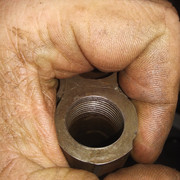That's completely untrue. I just measured a few choke tubes, Truchoke is the thinnest at ..795" OD, and Remchoke thickest at close to .818". Mike Orlen will thread for chokes, and he requires a minimum of .855" OD, and even then, he recommends Truchoke at that thickness. So he suggests .030" over the choke tube diameter. I had an unmentionable with a .860" OD barrel threaded for truchoke, and it is pretty thin. I'm not going to sit and measure barrels all day, so you will have to test for yourself that any12 gauge barrel made after about 1985 has an OD .860" or bigger. I just measured one of my unmentionable's O/U's from the 1940's, and the barrel OD is about .820" at the muzzle. It has the same OD as a modern choke tube!. Yes there are thinwalls, but they have problems, you do not want to use them if at all possible. Why anyone would install them, I don't know. They are not for hunting guns.
OK, so measuring my mid 1800's SXS, built in Birmingham, the breech end measures about 1.200". They aren't perfectly round, and each barrel is slightly different. The muzzles measure about .930". There's good evidence this was originally a 10 gauge bore, lets say .775". That makes the original wall thicknesses .213" at the breech, and .078 at the muzzles. That's thicker than my modern 10 gauge.






